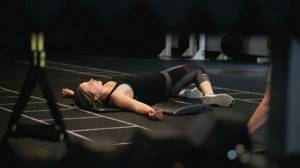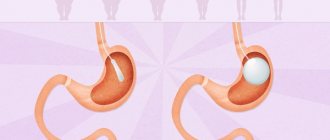Author: Mikhail Ziborov - author of the website makefitness.pro | more details >> I am a swimming coach at a youth sports school and a gym instructor.
Place in the ranking of authors:
17
(become an author) Date: 2020-11-11 Views: 3,280 Rating: 4.3
| All articles by the author >> | Medals articles >> |
Articles are loading...
We will talk about training in general: about cardio training (aerobic exercise) and strength training (anaerobic exercise). Let's consider both cases: is it possible to train on an empty stomach for cardio and for strength training?
From the material you will learn:
1. Disadvantages of training on an empty stomach. 2. Positive aspects of training on an empty stomach.
Theory about the benefits of training on an empty stomach
The basis of the theory was the discovery of the so-called “thrifty genes”, the task of which was to ensure the survival of our ancestors, hunter-gatherers, during prolonged periods of famine through the effective regulation and expenditure of energy. It was the “thrifty” genotype that allowed our ancestors to fully perform vital high-intensity interval training, such as escaping from a tiger or driving a mammoth, even when the pre-workout complex had ended for a couple of days in the cave.
Surprisingly, at the genetic level, we remain the same as we were 10,000 years ago, while our environment has undergone dramatic changes.1
Emptiness in the hall
Whatever one may say, there are few people in the gym in the morning, which will allow, in addition to circuit training (when exercises are performed one after another with virtually no rest), to perform supersets, drop sets and use other training methods that cannot be performed when it’s rush hour in the gym and there are queues for the exercise machines.
To ensure that your morning workout brings maximum benefits, remember these rules and train with pleasure, good luck!
The benefits of training on an empty stomach
Scientists are increasingly inclined to believe that, thanks to our “thrifty” genes, low levels of muscle glycogen during exercise stimulate certain metabolic processes in the body and improve muscle adaptation to physical activity. Studies have shown that training on an empty stomach not only improves aerobic endurance, but also promotes increased fat burning compared to training in a high muscle glycogen environment.3,4 Therefore, if you are looking to get lean through aerobic exercise, e.g. treadmill or exercise bike, then morning workouts on an empty stomach will lead to the desired result as quickly as possible.
The body after waking up
In the morning, after sleep, the body's reserves of glycogen and insulin in the blood are depleted. Why is this information important? Insulin slows down lipolysis, that is, fat breakdown, therefore, a person loses weight more slowly, and cholesterol accumulates in his blood. When glycogen is low, the body has to use its own energy (from fat reserves), which is not prevented by small amounts of insulin. Other processes in the body at this time reflexively slow down out of the principles of self-preservation.
At the same time, in the morning there is a high level of growth hormone, released as a reaction to the lack of food. It is this substance that accelerates fat breakdown. At the same time, insulin and growth hormone are interconnected - they slow down each other’s synthesis. Therefore, the morning hours are the optimal solution for those who want to burn fat reserves and lower cholesterol levels.
Disadvantages of training on an empty stomach
However, the same experiments established that positive metabolic changes in the body at the level of genes and enzymes do not always lead to improved physical performance, which plays a decisive role in sports competitions. For example, the distance that an athlete with initially low levels of muscle glycogen could run and his maximum oxygen consumption did not differ from athletes who had more fuel in their muscles.
Still, many physiologists in the field of sports are confident that by training with a low glycogen reserve, the athlete teaches his body to produce energy as efficiently as possible - this is precisely the goal of training. Athletic performance is the goal of competition, in which athletes always participate with maximum muscle glycogen reserves. Thus, a person accustomed to working with low fuel levels, in the presence of carbohydrates, is able to surpass the athletic performance of those athletes whose bodies did not undergo the same adaptation during preparation for competition. While this sounds good in theory, in practice we need more research to prove the truth of this claim. So if you're doing aerobic exercise not just for aesthetics and well-being, but also for competition purposes, you might want to experiment with training with low glycogen stores.
Low glycogen levels
Morning workouts on an empty stomach are not the only way to achieve glycogen depletion. The method described below is more suitable for professionals or amateur athletes when preparing for endurance competitions, and not for the average person.
To achieve a positive effect, you need to reduce the amount of glycogen in the muscles by 30-35%. To do this, you need to train for half an hour to an hour at an intensity at which your heart rate is 70% of the maximum allowable. To calculate your maximum heart rate, subtract your age from 220.
The second stage is training in a state of glycogen depletion. You can start it either immediately or one to three hours after the first workout, but without eating or high-calorie drinks. The second workout should be the same type of physical activity as the first. You should train either in the HIIT style for 30-40 minutes, when in high-intensity intervals the heart rate is 80-90% of the maximum allowable, or for an hour with a heart rate of 75% of the maximum allowable.
Duration of training
Be sure to monitor how you feel and how you recover between training stages, as well as the intensity and duration of your workout. You should train in this mode no more than once or twice a week for a limited period of time.

Training in the morning on an empty stomach: is it possible?
Early training on an empty stomach involves playing sports before breakfast, when a person runs, lifts dumbbells, etc. The effectiveness of such exercises is based on the expenditure of the body’s own resources to produce energy, in return for carbohydrates not supplied from outside. Exercising in this mode is useful for those who want to lose weight. For those who are focused on gaining weight, exercising on an empty stomach will allow you to slightly break down fat and dry out muscle tissue. The technique allows you to ultimately obtain the required muscle definition by resuming training on a full stomach.
Despite the apparent benefits, there are limitations to fasted training. It is not recommended for diabetics or people with liver problems to get involved in technology as a therapeutic measure. If training is indicated, the sports program is selected individually with the approval of the attending physician. Sports activities on an empty stomach for the listed pathologies are indicated because with an increase in muscle mass and a decrease in the percentage of body fat, the effect of insulin on cells improves, making it easier to control diseases. But in order not to faint from hunger, it is still recommended to eat 2-3 apples and drink a glass of juice 1-1.5 hours before training. But you shouldn’t eat heavily, because when exercising on a full stomach, the body will work at half capacity due to the need to waste a lot of energy not on training, but on the process of digesting food. Besides, it's harmful.
Strength training and its effects
The effect of such exercises in the early morning and on an empty stomach is purely positive, if not aggravated. With the right approach and proper selection of the program, accelerated fat breakdown and a decrease in cholesterol in the blood will occur due to the consumption of one’s own fat tissue, instead of absorbed from the outside. But if abused, the opposite effect will be achieved. Energy will be extracted from muscle tissue, since against the background of exhaustion and lack of fat deposits there is nowhere else to take it from.
When fasting and strength training are combined, somatotropin, the “elixir of youth,” begins to be intensively produced, which helps build muscles, burn fat, and strengthen bones. At the same time, physical endurance increases due to a jump in testosterone levels, which accelerates the functioning of organs and prevents the occurrence of depression, fatigue, and lethargy. Thanks to early training, the efficiency of glycogen storage in muscles increases and endorphin is produced - the hormone of happiness.
Running and walking on an empty stomach
The peculiarity of early cardio without breakfast is the acceleration of metabolism, which continues throughout the next day.

In addition to effectively burning fat when running or walking on an empty stomach, the positive effects are:
- acceleration of endorphin production, which improves mood;
- ensuring quick awakening with the launch of all organs and systems at the same time;
- regulation of appetite throughout the day;
- establishing a circadian regime, thanks to which it becomes possible to quickly adapt and improve physical capabilities;
- acceleration of metabolism.
The effectiveness of a cardio session is judged by the ability to burn fat after training, that is, over the next 3-4 hours. However, it is important to exercise wisely on an empty stomach. It is better to run for no more than half an hour, and during the rest of the day, avoid feeling hungry. The best option is to alternate between aerobic and anaerobic exercise.
Flaws
It is important to be aware of the potential disadvantages of this method of training:
- Increased release of stress hormones, which lower immunity and can lead to upper respiratory tract infections;
- Reduced workout duration due to faster onset of fatigue caused by low glycogen levels;
- Increased risk of burnout and overtraining;
- Increased risk of dehydration in hot climates (muscle glycogen holds three times its own weight in water);
- Increased risk of muscle damage and subsequent loss of muscle mass.
Personal experience
Despite the small amount of research, many practicing trainers talk about the effect of short morning sessions.
Jim Stopanni , a bodybuilding professional with a PhD in exercise physiology and biochemistry and the author of numerous articles and scientific papers on fitness and healthy living, notes that short fasted cardio helps his clients lose fat in the most problematic areas.
When a person has been training for a long time and has achieved good shape, but “stubborn” fat remains in small amounts on the stomach and thighs, Jim suggests looking for a way out in morning workouts. He does not provide a scientific basis for this effect, but only talks about many years of coaching experience.
Lyle MacDonald , a sports physiologist and specialist in body recomposition, supports Stopanni's point of view. He notes that such training will be especially effective for people who already have low levels of subcutaneous fat but have problem areas.
With a large volume of subcutaneous fat, blood supply to the problem area is reduced, which leads to even greater growth, since the breakdown and release of fats into the general bloodstream is limited.
| Therefore, it is impossible to remove a large amount of fatty tissue from the desired areas only through morning training, but it is quite possible to cope with a specific problem area with an already toned body. |
The experience of our students also confirms the effectiveness of short morning workouts. In the article #Tips of Approach, we have already described options for working with them: everything we have achieved at the cost of our own experience.
In 15 minutes of morning training (in which the intense part is only 5 - 10 minutes), you will receive energy from glycogen residues in the muscles and liver and partly from fat.
| From observations of our students, we can conclude that morning training is very effective for beginners. The “novelty effect” is triggered when the body is not yet accustomed to such loads. Over time, the body adapts to working out in the morning. |
This doesn't mean you need to make your morning routine endlessly difficult. Take a break. Leave only the joint warm-up, which helps to “wake up” the joints, and return to intense morning workouts after a couple of months, changing the exercises. Then they will be effective again for a while. You can learn more about how to balance between periods of intense training and rest in the article “Periodization of the training process.”
Even if you don’t have a goal to lose weight or “pump up,” morning exercises should not be ignored. Remember the benefits of joint warm-up or so-called morning hygienic exercises, which we were told about back in kindergarten.
In the morning, the body and brain are slightly slowed down, this is normal, because during sleep the processes of inhibition of the nervous system predominate in the body.
| Normally, a person needs about 2 hours after waking up to get to a “working” state. Morning exercises help reduce this time and enable the optimal regime in a shorter period of time. |
Gymnastic exercises increase the rate of heart contractions, therefore, increase the flow of oxygen to organs and systems after long sleep, increase the depth of breathing, slightly speed up the metabolism, and increase the tone of the nervous system (the reaction to various stimuli returns to normal, “lethargy” goes away).
The positive effect of morning exercises also extends to the gastrointestinal tract. Blood actively flows to the abdominal area, a kind of massage of the internal organs occurs due to tension in the anterior abdominal wall.
In addition, this is an additional portion of endorphins in the morning. Therefore, if your goal is to improve your body’s health, then joint exercises and a few simple exercises for 5 to 10 minutes will be enough.
Fasted cardio and body fat percentage
Let's divide those losing weight into three groups: slim people with muscles, people with obesity and people with a normal figure - with varying, but not fatal, amounts of excess weight.
Slender people with enough muscles

You can talk about slimness starting from 12-15% fat in men and 19-22% in women. This is where fat mobilization becomes a problem, and losing the “last” fat is difficult. But these people have no problems with fat oxidation - the body is trained and knows how to do it.
Variations of fasted cardio (both interval and regular) combined with a carbohydrate-restricted diet can solve the problem of mobilizing “difficult” fat. And this is the only category of people for whom fasted cardio brings results different from regular cardio.
Obese people

At the other end are obese people (30-35%+ body fat) and the problem is the opposite. There is always a huge amount of fatty acids in their blood, and there are no difficulties with their mobilization. But they have great difficulty burning them at the third stage. The release of fatty acids into the bloodstream far exceeds the rate at which the body can use them. Unused fatty acids are returned to fat depots. And this can be harmful to blood vessels: a large amount of fats in the blood leads to atherosclerosis.
Regular figure
Between these two extremes (that is, in the range of 20-35% body fat in women) lies a normal figure, and such people have no problems losing weight. Mobilization is not a problem because the body has so far begun to resist getting rid of the last fat. Transport is also not a problem, since stubborn fat in problem areas is not yet the main target. And oxidation is rarely a problem either. For this category of people, the time of doing cardio and its type (on an empty stomach or not) does not matter. While simple methods work, it makes no sense to use the methods of advanced athletes who are trying to get to the minimum percentage of body fat.
Research

The purpose of the study, conducted for the Journal of the International Society of Sports Medicine, was to examine changes in fat and lean body mass over 4 weeks using fasted and fasted cardio training in young women following a calorie-restricted diet.
Twenty young and healthy women with experience in cardio training (without strength training) were randomly divided into two groups. All participants consumed the same amount of calories in a deficit, and the workouts were also the same: 1 hour of low-intensity cardio three times a week.
The first group took the combination shake as a meal replacement before cardio, while the second trained on an empty stomach and took the same shake after the workout.
The findings of this study are significant for two reasons:
- The body's ability to oxidize fats during training develops as a result of adaptation: over time, the body increases the number of cell mitochondria - the ovens in which fats are burned, and the enzymes with the participation of which this happens, and accordingly, develops a better ability to use fats as energy. An untrained person uses fats as fuel less efficiently. That is why all participants had the same training experience.
- The presence of muscle mass may influence fatty acid catabolism. If some women had a lot of muscle, fasted cardio would be more effective for them, and the study would not be objective.
What did you find?
All participants lost the same amount of weight, regardless of whether they trained on an empty stomach or not. According to the first law of thermodynamics, in order to lose mass, you need to create a negative energy balance. The participants lost excess weight simply because they dieted and basically exercised, which allowed them to burn more calories than they consumed.
conclusions
The above gives us the answer to the question: does fasted cardio help you lose weight faster? For lean people who want to get even leaner (15% body fat or less for men, 22% body fat or less for women), different strategies, including fasted cardio, make sense to help mobilize stubborn fat more easily. That's why this particular group of people discovered decades ago that this kind of cardio worked better.
But for people who have some amount of excess weight (which is the majority), it doesn't matter when to do cardio. The best time is the one that allows you to do it regularly and not miss it. Whether it’s the first half of the day or the second, it doesn’t matter. If you like morning street runs before breakfast, then do them, but only because you like them, and not because they burn twice as much fat compared to regular “fed” cardio.
Protein
After these facts, you may be thinking, “even if exercising on an empty stomach is beneficial in the short term, does fasting affect protein digestion and muscle mass?” In fact, studies in young, middle-aged, and elderly adults have found that you can take your daily dose of protein at one time without harmful effects. To back this up, it's worth mentioning that there is some evidence that eating once or twice a day is more effective for building lean muscle mass.
In general, if you are not an athlete, then your strategy can be quite simple. If you don't want to eat, then don't eat.
Speaking about training on an empty stomach, we can say the following: skipping one or two meals before training will not harm your body. Intermittent fasting can reverse the effects of a sedentary, high-fat, high-calorie diet and make more efficient use of the food you eat. Working out in the morning on an empty stomach will help you better absorb the foods you eat after your workout.
Exercises on an empty stomach for weight loss
The question of whether you should practice exercises on an empty stomach to lose body weight is not as clear-cut as it seems. Although it seems that everything is simpler than that: after skipping a meal, the body has nowhere to get energy and it begins to take it by burning fat.
For example, a study at the University of Bath in the UK found that when overweight people briskly walked for 60 minutes on an empty stomach, their bodies switched to increased burning of stored fat (not carbohydrates) compared to the group that ate before. training.
“Overweight people respond differently to fasted exercise—they typically increase their metabolic rate faster than healthy people,” says Darrin S. Willoughby, Ph.D., director of the Exercise and Biochemical Nutrition Laboratory at Baylor University in Texas. .
This is confirmed by the British Journal of Nutrition, reporting findings from a 2013 study. When exercising on an empty stomach, people lost 20% more fat than people who had a small snack before exercise.
Another experiment published in the International Journal of Sports Nutrition and Exercise Metabolism found the same result: Fasted aerobic exercise reduced body fat percentage more than pre-workout meals.
Is it better to do exercises on an empty stomach?
If you want to hear the answer right away, it will be “Yes”
Does this mean all the talk about pre-workout nutrition was in vain? Not really.
Some studies have shown that consuming carbohydrates before exercise allows athletes to exercise longer than when training in a fasted state.
Another study found that men in a fasted state ran significantly shorter distances in 60 minutes. Compared to men who ate pre-workout. This was despite no significant differences in heart rate and perceived exertion.
But while not eating before a sporting event will not help you achieve outstanding results, training on an empty stomach for amateur sports can help in other ways. Especially for those who care more about their waistline than their marathon results.
Another of the many studies conducted on this topic concluded that men aged 18-25 who did fasted cardio exercise while eating a high-fat, high-calorie diet had improved glucose handling and insulin sensitivity compared to those who exercised without refusing food before exercise or those who did not exercise at all.
Of these three groups, only those who did the exercises on an empty stomach did not gain weight.









